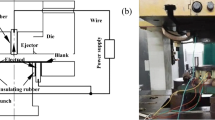Abstract
Deep drawing is a process of converting sheets into cup-like-shaped components. It is a complex process, and process parameters play an important role. In this paper, two deep drawing processes namely warm deep drawing and hydromechanical deep drawing are compared. A 20-t hydraulic press is used to draw the cups. To ensure drawing at a fixed temperature in warm forming, heaters are connected to the lower die. Experimental results are compared with finite element simulations. Coefficient of friction in simulation is calculated by inverse analysis of comparing the load displacement curves. In hydromechanical deep drawing, the process is assisted by a hydraulic counter pressure. The peak load obtained in hydromechanical deep drawing has been found to be significantly higher than the peak load in both warm and conventional deep drawing and is influenced by the clearance between punch and die and the maximum counter pressure in the fluid chamber. Limiting draw ratio (LDR), von Mises stresses, and thickness distribution in the drawn cups by varying the temperature of the blank in case of warm forming and varying the pressure in case of hydromechanical deep drawing are studied using experiments and finite element simulation.
Similar content being viewed by others
References
Singh SK, Gupta AK, Mahesh K (2010) Prediction of mechanical properties of extra deep drawn steel in blue brittle region using Artificial Neural Network. Mater Des 31:2288–2295
Singh SK, Swathi M, Mahesh K, Gupta AK (2010) Understanding formability of EDD steel at elevated temperatures using finite element simulation. Mater Des 31:4478–4484
Singh SK, Ravi Kumar D (2008) Effect of process parameters on product surface finish and thickness variation in hydro-mechanical deep drawing. J Mater Process Technol 204(1–3):169–178
Nakagawa T, Nakamura K, Amino H (1997) Various applications of hydraulic counter pressure deep drawing. J Mater Process Technol 71:160–167
Amino H, Nakamura K, Nakagawa T (1990) Counter-pressure deep drawing and its application in the forming and automobile parts. J Mater Process Technol 23:243–265
Yossifon S, Tirosh J (1992) Deep drawing with a fluid pressure assisted blank holder. Proc Inst Mech Eng 206:247–252
Yossifon S, Tirosh J (1985) Rupture instability in hydroforming deep-drawing process. Int J Mech Sci 27(9):559–570
Wilson WRD (1991) Friction models for metal forming in the boundary lubricant regime. J Eng Mater Technol 113:60–68
Singh SK, Ravi Kumar D (2005) Application of neural network to predict thickness strains and finite element simulation of hydro-mechanical deep drawing. Int J Adv Manuf Technol 25(1–2):101–107
Singh SK, Dixit A, Ravi Kumar D (2008) Optimization of the design parameters of modified die in hydro-mechanical deep drawing using LS-DYNA. Int J Adv Manuf Technol 38(1):32–37
Wang XW, Zhu XH (1995) Numerical simulation of deep-drawing process. J Mater Process Technol 48:123–127
Chen FK, Huang TB, Chang CK (2003) Deep drawing of square cups with magnesium alloy AZ31 sheets. Int J Mach Tool Manuf 43(15):1553–1559
Correia JPDM, Ferron G (2002) Wrinkling predictions in the deep-drawing process of anisotropic metal sheets. J Mater Process Technol 128(1–3):178–190
Singh SK (2005) Some investigations in hydromechanical deep drawing. Ph.D. Thesis, Department of Mechanical Engineering, IIT Delhi, India
Kim TJ, Yang DY, Han SS (2004) Numerical modeling of the multistage sheet pair hydroforming. J Mater Process Technol 151(1–3):48–53
Qin Y, Balendra R (2003) Design considerations for hydromechanical deep drawing of sheet components with concave features. J Mater Process Technol 145(2):163–170
Wu J, Balendra R, Qin Y (2003) A study on the forming limits of the hydromechanical deep drawing of components with stepped geometries. J Mater Process Technol 145(2):242–246
Tirosh J, Konvalina P (1985) On the hydrodynamic deep-drawing process. Int J Mech Sci 27(9):595–607
Lang L, Danckert J, Nielsen KB (2004) Study on hydromechanical deep drawing with uniform pressure onto the blank. Int J Mach Tool Manuf 44(5):495–502
Lang L, Danckert J, Nielsen KB (2004) Investigation into hydrodynamic deep drawing assisted by radial pressure: part I. Experimental observations of the forming process of aluminum alloy. J Mater Process Technol 148(1):119–131
Nakamura K, Nakagawa T (1987) Sheet metal forming with hydraulic counter pressure in Japan. Ann CIRP 36(1):191–194
Van Den Boogaard AH, Hu’etink J (2006) Simulation of aluminum sheet forming at elevated temperatures. Comput Methods Appl 195:6691–6709
Gupta AK, Singh SK, Swathi M, Gokul H (2012) Prediction of flow stress in dynamic strain ageing regime of austenitic stainless steel 316 using artificial neural network. Mater Des 35:589–595
Singh SK, Gupta AK, Mahesh K (2010) A study on the extent of ironing of EDD steel at elevated temperature. CIRP J Manuf Sci Technol 3(1):73–79
Erdin ME, Aykul H, Tunalioglu MS (2005) Forming of high strength/low formability metal sheets at elevated temperatures. Math Comput Appl 10(3):331–340
Hallquist JO (1998) Dynaform manual, v1. 01
Chung WJ, Cho JW, Belytschko T (1998) On the dynamic effects of explicit FEM in sheet metal forming analysis. Eng Comput 15:750–776
Taylan A, Hyunok K, Ji Hyun S, Rajesh S (2007) Evaluation of stamping lubricants using the deep drawing test. Int J Mach Tools Manuf 47:2120–2132
Van den Boogaard AH, Bolt PJ, Werkhoven RJ (2001) Modeling of AlMg sheet forming at elevated temperatures. Int J Form Process 4:361–375
Bolt PJ, Lamboo NAPM, Rozier PJCM (2001) Feasibility of warm drawing of Al products. J Mater Process Technol 115:118–121
Singh SK, Ravi Kumar D (2008) Effect of process parameters on product surface finish and thickness variation in hydro-mechanical deep drawing. J Mater Process Technol 204:169–178
Zhang SH, Jensen MR, Nielsen KB, Danckert J, Lang LH, Kang DC (2003) Effect of anisotropy and prebulging on hydromechanical deep drawing of mild steel cups. J Mater Process Technol 142(2):544–550
Author information
Authors and Affiliations
Corresponding author
Rights and permissions
About this article
Cite this article
Desu, R.K., Singh, S.K. & Gupta, A.K. Comparative study of warm and hydromechanical deep drawing for low-carbon steel. Int J Adv Manuf Technol 85, 661–672 (2016). https://doi.org/10.1007/s00170-015-7819-2
Received:
Accepted:
Published:
Issue Date:
DOI: https://doi.org/10.1007/s00170-015-7819-2



